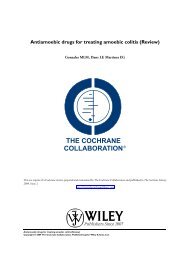Ivermectin for onchocercal eye disease (river blindness) (Review)
Ivermectin for onchocercal eye disease (river blindness) (Review)
Ivermectin for onchocercal eye disease (river blindness) (Review)
You also want an ePaper? Increase the reach of your titles
YUMPU automatically turns print PDFs into web optimized ePapers that Google loves.
Main results<br />
The review included four trials: two small studies (n=398) in which people with <strong>onchocercal</strong> infection were given one dose of ivermectin<br />
or placebo and followed up <strong>for</strong> one year; and two larger community-based studies (n=4941) whereby all individuals in selected<br />
communities were treated every six or 12 months with ivermectin or placebo, whether or not they were infected, and followed <strong>for</strong><br />
two to three years. The studies provide evidence that treating people who have onchocerciasis with ivermectin reduces the number of<br />
microfilariae in their skin and <strong>eye</strong>(s) and reduces the number of punctate opacities. There was weaker evidence that ivermectin reduced<br />
the risk of chorioretinitis. The studies were too small and of too short a duration to provide evidence <strong>for</strong> an effect on sclerosing keratitis,<br />
iridocyclitis, optic nerve <strong>disease</strong> or visual loss. One community-based study in communities mesoendemic <strong>for</strong> the savannah strain of<br />
O.volvulus provided evidence that annual mass treatment with ivermectin reduces the risk of new cases of optic nerve <strong>disease</strong> and visual<br />
field loss. The other community-based study of mass biannual treatment of ivermectin in communities affected by the <strong>for</strong>est strain of<br />
O.volvulus demonstrated reductions in microfilarial load, punctate keratitis and iridocyclitis but not sclerosing keratitis, chorioretinitis,<br />
optic atrophy or visual impairment. The study was underpowered to estimate the effect of ivermectin on visual impairment and other<br />
less frequent clinical signs. The studies included in this review reported some adverse effects, in particular an increased risk of postural<br />
hypotension in people treated with ivermectin.<br />
Authors’ conclusions<br />
The lack of evidence <strong>for</strong> prevention of visual impairment and <strong>blindness</strong> should not be interpreted to mean that ivermectin is not<br />
effective, however, clearly this is a key question that remains unanswered. The main evidence <strong>for</strong> a protective effect of mass treatment<br />
with ivermectin on visual field loss and optic nerve <strong>disease</strong> comes from communities mesoendemic <strong>for</strong> the savannah strain of O.volvulus.<br />
Whether these findings can be applied to communities with different endemicity and affected by the <strong>for</strong>est strain is unclear. Serious<br />
adverse effects were rarely reported. None of the studies, however, were conducted in areas where people are infected with Loa loa<br />
(loiasis).<br />
P L A I N L A N G U A G E S U M M A R Y<br />
<strong>Ivermectin</strong> <strong>for</strong> <strong>river</strong> <strong>blindness</strong> (onchocerciasis)<br />
Onchocerciasis is caused by tiny worms and is transmitted from person to person by a small biting fly. The fly breeds in fast flowing<br />
<strong>river</strong>s and streams mainly in West Africa. The <strong>disease</strong> causes severe itching and thickening of the skin and damages structures at the<br />
front and back of the <strong>eye</strong>. It also affects the nerve that connects the <strong>eye</strong> with the brain.<br />
Four studies based in west Africa were included in the review; two small studies in Ghana and Liberia and two larger communitybased<br />
ones in Nigeria and Sierra-Leone. In the smaller studies, people with <strong>onchocercal</strong> infection were given one dose of ivermectin or<br />
placebo and followed up <strong>for</strong> one year. In the larger studies all individuals in selected communities were treated every six or 12 months<br />
with ivermectin or placebo, whether or not they were infected, and followed <strong>for</strong> two to three years. This review found that ivermectin<br />
can prevent damage to the front of the <strong>eye</strong> but its effectiveness in preventing <strong>blindness</strong> remains uncertain.<br />
<strong>Ivermectin</strong> <strong>for</strong> <strong>onchocercal</strong> <strong>eye</strong> <strong>disease</strong> (<strong>river</strong> <strong>blindness</strong>) (<strong>Review</strong>)<br />
Copyright © 2009 The Cochrane Collaboration. Published by John Wiley & Sons, Ltd.<br />
2








